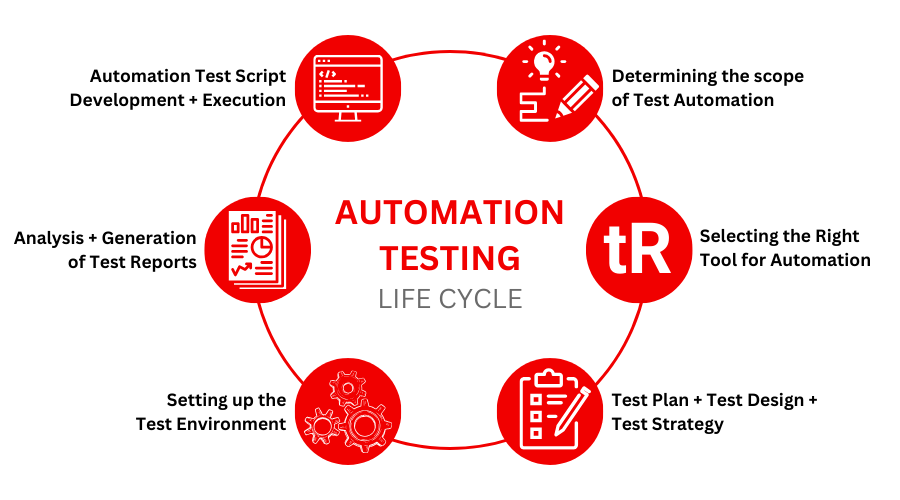Making Sure Success in Automation Testing: Secret Metrics, Obstacles, and Solutions Every QA Team Ought To Know
In the world of software high quality guarantee, the landscape of automation testing is ever-evolving, demanding a careful approach to make certain seamless operations. Secret metrics act as the compass guiding QA teams with the substantial surface of test automation, dropping light on development and locations for improvement. Obstacles loom big, often casting shadows on the path to success. By comprehending these obstacles and applying reliable solutions, QA teams can navigate with intricacies with skill. The trip to understanding automation testing is paved with nuances that require a keen eye for tracking, analysis, and constant renovation. automation testing. As the industry pushes ahead, the mission for optimum efficiency in automation screening stays a consistent search, urging QA teams to equip themselves with the knowledge and techniques vital for victory.
Significance of Key Metrics
Comprehending the relevance of essential metrics is important for reviewing the performance and effectiveness of automation screening processes. Trick metrics work as quantifiable actions that offer valuable understandings into numerous elements of the screening process, such as examination protection, examination execution time, issue thickness, and examination situation efficiency. By examining these metrics, QA teams can determine bottlenecks, inadequacies, and locations for enhancement within their automation testing framework.
One crucial element of key metrics is their capability to track progression and keep an eye on the total health of the screening procedure (automation testing). They allow stakeholders to make enlightened decisions based on data-driven understandings, which can lead to a lot more reliable testing methods and far better resource allotment. In addition, key metrics can assist groups established realistic goals, gauge the success of automation initiatives, and demonstrate the ROI of automation testing initiatives

Usual Obstacles Dealt With
Challenges commonly encountered in automation screening processes can significantly affect the general efficiency and performance of QA teams. Among the major challenges is the choice of the best examination situations for automation. Not all examination situations are appropriate for automation, and choosing the incorrect ones can result in wasted time and resources. Additionally, preserving test manuscripts can be a complicated task, specifically as the application goes through frequent modifications. Examination manuscript maintenance needs continual updates and adjustments to guarantee they reflect the existing capability properly. One more common challenge is the preliminary financial investment needed for establishing automation structures and devices. This can be a barrier for some organizations, specifically smaller ones with restricted spending plans. Furthermore, automation screening might not cover all aspects of testing, such as use and user experience testing, which still need hand-operated intervention. Getting rid of these obstacles requires proper planning, strategic examination instance selection, robust maintenance procedures, adequate resources, and a clear understanding of the constraints of automation testing.
Reliable Solutions for Challenges
To attend to the barriers run into in automation screening, applying reliable services is vital for enhancing the performance and productivity of QA teams. One key solution is to purchase robust training programs for QA groups to guarantee they have the necessary skills to successfully use automation devices. Training can connect knowledge voids, enhance understanding of automation frameworks, and boost scripting abilities, ultimately bring about much more efficient examination visit this site development and execution.
One more important solution is to develop clear communication networks within the QA team and with various other stakeholders, such as developers and task managers. Efficient communication aids in lining up assumptions, sharing development updates, and promptly attending to concerns or obstructions that might arise throughout the automation screening process.

Surveillance and Evaluation Techniques
Executing reliable tracking and evaluation methods is essential for ensuring the success and performance of automation testing procedures. Additionally, examining test outcomes and metrics offers important understandings into the high quality of the software being tested and the performance of the screening technique.
One key strategy in tracking and evaluation is using dashboards that settle relevant metrics and KPIs in an aesthetically obtainable layout. These dashboards provide a comprehensive summary of examination implementation status, examination coverage, problem fads, and other essential information. Consistently evaluating and examining these dashboards can assist QA groups make notified choices, prioritize tasks, and enhance screening initiatives.
Moreover, implementing automated notifies and notices based upon predefined thresholds can improve aggressive tracking and prompt treatment. By setting up notifies for efficiency variances or examination failures, teams can deal with problems without delay and stop them from intensifying. Generally, tracking and analysis techniques play a vital role in guaranteeing the effectiveness and success of automation screening campaigns.
Continual Renovation Methods
Enhancing the efficiency of automation testing procedures requires the consistent improvement of methods and strategies. One crucial approach to boosting automation testing procedures is to carry out regular reviews and retrospectives.

Final Thought
Finally, it is vital for QA teams to recognize the essential metrics, challenges, and options in automation testing to make sure success. By thoroughly monitoring and assessing data, applying reliable services to usual challenges, and continually improving methods, QA teams can enhance their screening processes and provide high-quality software program products. Following these techniques will ultimately cause more effective and effective automation screening practices.
By examining these metrics, QA groups can identify bottlenecks, inadequacies, and areas for improvement within their automation screening framework.
In addition, essential metrics can aid groups established reasonable goals, gauge the success of automation campaigns, and demonstrate the ROI of automation testing efforts.
Difficulties frequently run into in automation testing processes can considerably affect the general performance and effectiveness of QA teams. Automation testing may not cover all aspects of testing, such as functionality and individual experience testing, which still need hand-operated treatment.In verdict, it is crucial for QA groups to understand the key metrics, challenges, and services in automation testing to guarantee success.
Comments on “The Importance of Automation Testing in Agile Development Environments”